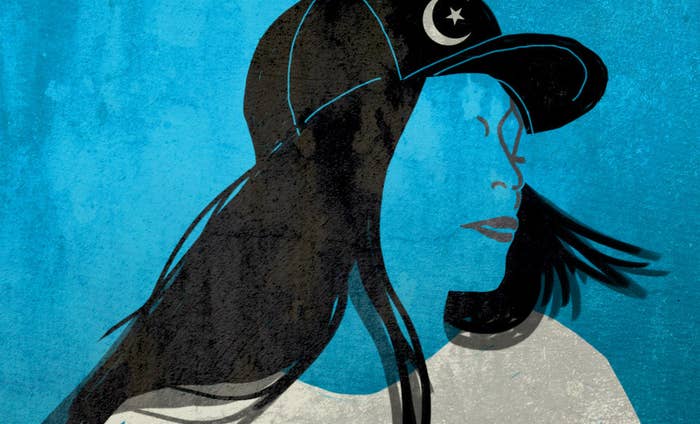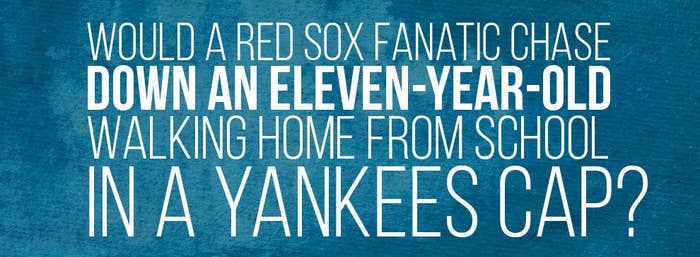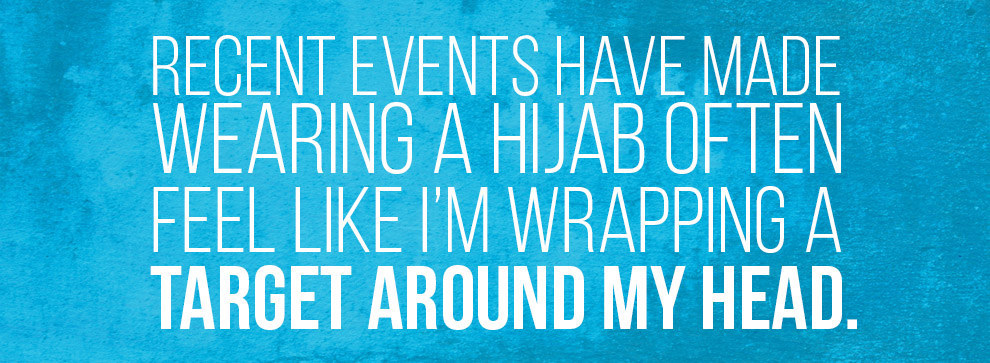
I was walking home from school one day, alone and happy. I loved walking home alone. "I'm independent," I used to think. It was early 2002 and I was in fifth grade. I was at the tail end of the journey, crossing the Long Island Railroad tracks that ran parallel to my house. But as soon as I made it to the other side I heard a high-pitched screech. I turned around. I met the angry eyes of a woman in a beat-up red sedan with children in the back seats. The railroad tracks separated us but — after looking at me and then in the opposite direction — she made an abrupt U-turn. She drove across the tracks. I walked quickly toward my house, looking over my shoulder as the woman drove toward me. She pulled up. I stopped. I was two blocks from home. She rolled down her window and yelled, "TAKE THAT OFF YOUR HEAD."
I stood there, shocked. I had started wearing the baseball cap a year earlier, when my parents uprooted my three older brothers, three cousins, and me from Ozone Park, Queens to Long Island in search of a better school system and a bigger house. I knew that eventually I wanted to wear a baseball cap, so why not start right when I moved to this new neighborhood? "I don't want people to be surprised when I start wearing it all of a sudden," I remember telling my dad before we moved. "Wearing a baseball cap full time is a big decision," he cautioned, albeit proudly.
"I know, Abbu," I would groan.
I thought I understood — in whatever terms my elementary school mind could — what I was getting into when I decided to wear a baseball cap. In the first year I was lucky enough to have the luxury of chalking up the glares I felt when I walked into an upscale department store or the airport to paranoia. Maybe it's just in my head. Maybe that's how his face always is.
It wasn't until that hatred came rolling down the street in an old red sedan that I truly knew what my dad was warning me about. As the woman drove away, I remembered the day after Sept. 11, a few months earlier. My dad struggled with whether to send my cousin and me to school. We wore baseball caps, after all. The caps symbolized everything people who wrongly associated terrorism with baseball feared and hated. But, ultimately, my father refused to let fear dictate our lives.
In the year that I started wearing it full time, the baseball cap became so natural, almost instinctive to me, that I often forgot there was something on my head. It was, and is, like a second skin. It is not just an accessory. It is not just a baseball cap. In fact, it's not a baseball cap at all — it's a hijab.

But you probably already guessed that. And yet lawyers for preppy retailer Abercrombie & Fitch argued in front of the Supreme Court last week that it declined to hire a 17-year-old Muslim woman because her hijab violated its no-baseball-caps dress code, and not because of religious discrimination. Their defense? They would have done the same to any applicant wearing a head covering, be it a "headscarf, a baseball cap, a helmet or another religious symbol."
The justices were skeptical of the baseball cap defense, as am I. Would my father hesitate to send his young niece and daughter to school wearing baseball caps during the peak of anti-Islamic sentiment in America? Do the owners of snapbacks consider them an extension of themselves? Would a Red Sox fanatic chase down an 11-year-old walking home from school in a Yankees cap?
The defense acknowledged the difference, arguing that it was up to the young woman, named Samantha Elauf, to ask for a religious exception to the employee dress code in her interview. "If she had told him, this is for religious belief and I need an accommodation from the Look Policy, at that point, under the statute, there would be a duty to accommodate," said Shay Dvoretzky, the lawyer arguing on behalf of Abercrombie.
In other words: A stranger could pinpoint exactly what my hijab symbolized from across a pair of railroad tracks, but when Elauf went in for her interview Abercrombie & Fitch saw nothing but an accessory? They couldn't guess she would need a religious accommodation?
That's the thing: You can't have it both ways. The hijab cannot be the reason why some people who wrongly think it represents terrorism and oppression hate and judge us but then be brushed off as nothing more than a baseball cap when it is convenient.
Abercrombie isn't the only entity to treat the hijab like an accessory. In Quebec last week, a judge told Rania El-Alloul that she would not hear her case unless she took off her hijab. "I will therefore not hear you if you are wearing a headscarf on your head just as I would not allow a person to appear before me wearing a hat or sunglasses on his or her head…" the judge told El-Alloul.
Meanwhile, Muslim women around the world are fighting for their right to wear the hijab. Even in the United States, where we are guaranteed freedom of religion, some Muslim women are verbally or physically attacked. A friend, also a hijabbi (someone who wears the headscarf), told me this past summer a woman shoved her in the middle of the street in New York. Nobody around her did or said anything. Another friend, Sarah, was chased through a crowded train car by a man who was violently coughing and spitting on her.

This hatred is real, and sometimes it's deadly. Days after Deah Barakat and his hijab-wearing wife, Yusor Mohammad, and sister-in-law Razan Mohammad were shot in North Carolina (allegedly over a parking dispute), a Rhode Island Islamic school was vandalized. In Sweden last month, three mosques were burnt down by anti-Islam arsonists.
Recent events often have made wearing a hijab feel like I'm wrapping a target around my head. I still do it proudly. (And hey, I'm hard to both miss and forget — valuable assets for a reporter.) In the past 12 years, I have grappled with my own interpretation of the concept and the meaning behind the hijab, like many Muslim women around the world do. I have gone through different phases of styles and fashions — like matching the exact color of my hijab to my outfit which, thank God, I stopped doing. But most importantly I've developed a deep understanding of my relationship with my hijab. It's a growing relationship — a journey really — that Muslim women everywhere navigate at their own pace.
And the idea isn't simply covering your head. (On the contrary, many women find other ways to embody the concept). It goes beyond that. It is a state of being. It is, above all, following God's will by being humble, modest, proud of who you are, and confident that what you have to offer is much more valuable than what you are on the surface. To me, it's empowering. I am in control. I get to choose who can and cannot see parts of my body.
But at the same time, I walk more carefully on subway platforms, staying away from the edge, and I sometimes hold a key in between my knuckles if I'm walking home late at night. My friend doesn't wear headphones while walking outside to make sure she's fully aware of her surroundings. "These are normal things I think about on a regular basis," she told me. Practically, everywhere we go, we field suspicious glances, angry glares, and personally, I cringe a little when I pass a cop, imagining what I would say if they asked to search my things.
The hijab is not just an accessory that you wear to represent your team or when you have a bad hair day (although it is very good for that). If it were as meaningless as that, that woman wouldn't have been offended enough by it to drive the wrong way with her children in the back seat to scream at an 11-year-old to take it off, women around the world wouldn't be fighting for their right to wear it, and most important, the decision to wear it wouldn't take as much courage as it often does.
